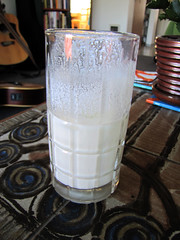Kefir
 My friend E from my knitting group asked me a few months ago if I was interested in making kefir at home. Kefir is a cultured milk drink, and it’s so simple to make that I decided I was definitely interested. E gave me some kefir grains and I started figuring out how to make it work for me. After a few false alarms where I thought I’d killed the little critters, I’m now on my routine of straining out my cultures in the morning, drinking the kefir plain or blended with frozen fruit, and adding another cup of milk to the cultures for the following day. I’ve been keeping the container in a bowl of water since it gets really hot in our apartment and the kefir is supposed to stay between 65° and 75°F. I like it plain, it’s not as sour as yogurt, but not sugary-sweet like milk. But blended with a few frozen strawberries and a squirt of honey – that’s REALLY good. I was hoping I would achieve health nirvana but I still came down with a summer cold… oh, well. At the very least I’m getting my calcium intake!
My friend E from my knitting group asked me a few months ago if I was interested in making kefir at home. Kefir is a cultured milk drink, and it’s so simple to make that I decided I was definitely interested. E gave me some kefir grains and I started figuring out how to make it work for me. After a few false alarms where I thought I’d killed the little critters, I’m now on my routine of straining out my cultures in the morning, drinking the kefir plain or blended with frozen fruit, and adding another cup of milk to the cultures for the following day. I’ve been keeping the container in a bowl of water since it gets really hot in our apartment and the kefir is supposed to stay between 65° and 75°F. I like it plain, it’s not as sour as yogurt, but not sugary-sweet like milk. But blended with a few frozen strawberries and a squirt of honey – that’s REALLY good. I was hoping I would achieve health nirvana but I still came down with a summer cold… oh, well. At the very least I’m getting my calcium intake!
Here is what I do:
1. Keep at room temperature (65° – 75°) in a loosely covered opaque plastic or glass container.
2. After 12-24 hours, strain into a bowl or glass, stirring gently to separate milk solids from kefir grains (They look like little cauliflower heads).
3. Drink as-is or blend with frozen fruit.
4. Wash your container, put the grains back in, add milk, and repeat from step 1.
Tips:
Use plastic (non-metal) utensils if possible
On hot days, keep the kefir container in a bowl of water (add an ice cube to the water if you are worried it’s getting too warm) and place it in a cupboard or closet in the coolest part of your home.
To store kefir grains, put just a small amount of milk in the container and keep in the fridge. Change the milk every few days until you are ready to start a new batch.
It will take some experimentation to find a good proportion of cultures to milk. I find that more cultures will ferment less milk in less time. So if it seems to be taking too long, try adding less milk next time. The cultures will grow and multiply, so eventually you will be able to culture more milk (or the same amount in less time.)

It is quite popular in certain part of China. I have never tried it but my hubby loves it. Do you know if there is any store sells it?
I’m not sure where you could buy the culture grains. But it’s easy to find prepared Kefir – here in Eugene, Nancy’s brand is common.